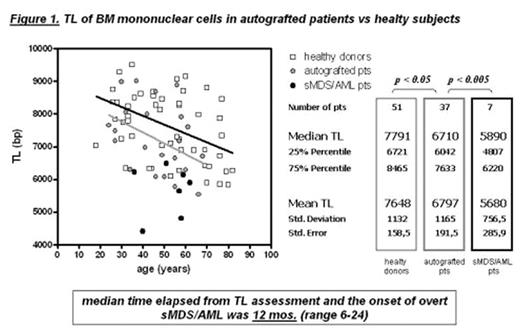Abstract
Introduction: Secondary myelodysplastic syndrome and acute myelogenous leukemia (sMDS/AML) may occur following autologous stem cell transplantation (ASCT). The molecular pathogenesis of sMDS/AML is uncertain; moreover, no suitable indicators able to define the risk of sMDS/AML development have been identified so far. A marked though variable telomere loss has been observed in hematopoietic cells following ASCT; meanwhile, shortening of telomere length has been observed to be associated with several neoplasias, including haematological malignancies. Thus, telomere dynamics has been investigated in a series of patients who received ASCT, in order to verify whether the degree of telomere loss in hematopoietic cells might be associated with the risk of sMDS/AML development.
Methods: Telomere length (TL) was retrospectively evaluated in bone marrow (BM) cells from 38 lymphoma patients (M/F=24/14; median age=51 years, range 24–68) long-term survivors following ASCT and from 51 healthy donors (M/F=31/20; median age=53 years, range 18–82). Median follow-up since ASCT was 6 years (range 1–10). All patients were in continuous complete remission and displayed normal haematological values at the time of TL assessment. Among 38 autografted patients, 7 developed sMDS/AML (3 AML, 3 sMDS, 1 persistent pancitopenia with cytogenetic abnormalities), at a median of 5 years (range 1–10) following transplant. There were no significant differences in terms of demographical and clinical features not even for the amount of CD34+ve cells reinfused (median values: 5.2 vs 6.8 × 106 CD34+ cells/kg, respectively), between patients developing sMDS/AML and the remaining autografted patients. Samples for TL analysis were obtained and stored at a median of 12 months (range 6–24) before clinical development of sMDS/AML. TL was evaluated by Southern blot analysis.
Results: TL of autografted patients was found to be significantly shorter compared to that of age-matched healthy donors, consistently with previous reports (see Figure 1, squares=healthy controls, circles=autografted subjects). A further TL loss was observed in all the 7 patients who subsequently developed sMDS/AML; their TL (Figure 1, black circles) was significantly shorter compared to both healthy subjects and sMDS/AML-free autografted patients (Figure 1, grey circles) (p<0.0005 and p<0.01, respectively).
Conclusions. A marked telomere loss seems to be a predictive marker of the development of sMDS/AML following ASCT; TL analysis can now be considered among follow-up assays, in order to early identify patients at high-risk of sMDS/AML occurrence following autograft.
TL of BM mononuclear cells in autografted patients vs healthy subjects
Author notes
Disclosure: No relevant conflicts of interest to declare.


This feature is available to Subscribers Only
Sign In or Create an Account Close Modal